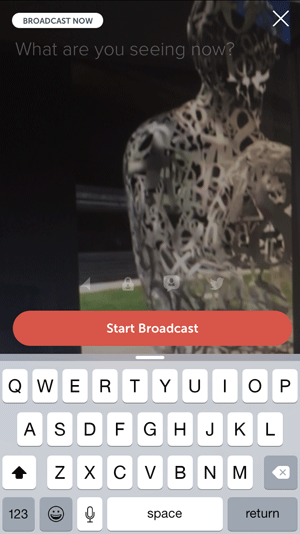To catch the ball, you got to play — and miss some
If you are a digital professional working in higher education, you know that new platforms, websites and shiny objects come and go. You also know that a few stay and become major communication platforms (facebook, twitter, instagram, etc.) — in no time.
That’s why part of your job is to experiment with emerging platforms to learn how to use them and find out if they can help you reach your communication and marketing goals down the road.
BIG DISCLAIMER (to avoid being quoted – out of context – in a future presentation from Michael and Gil ;0):
I’m NOT about to say that you should drop everything else you are doing and focus ALL your attention, budget and resources on new platforms.
However, it is important to keep an eye on and experiment with emerging technologies and platforms if you want to be ready if/when it becomes necessary. Innovation plays a big role for our audience of students (it’s a side effect of youth ;-). So, if you work for a college, it’s never a good idea to be THAT person stuck in the past. Our job is always a balance between the new and the tried and true.
What is Periscope?
There was a lot of chatter around Periscope and a similar app, Meerkat, this spring (at and after SXSW – THE geek festival that has become a big launching platform for any tech start-up planning to make it big)
Both platforms let you stream live videos from your smartphone. This is NOT something totally new: it was already possible with Google Hangout and Skype.
What’s original though is that both mobile apps allow you to broadcast to an “unlimited” number of people you know — and total strangers.
Anybody aware of the live streaming (because they follow you and got an app notification, they stumble at the right time on the link to the stream you shared elsewhere or they check what’s live now in the app) can not only watch the video live but also interact in real time with you through the app.
Viewers can send comments automatically attributed to their account (not anonymous) and/or “show their love” for what they see by sending “hearts” via the app that appear in real time on your screen.
 Instant video. Instant feedback. 2-way communication in the instant. That’s pretty powerful.
Instant video. Instant feedback. 2-way communication in the instant. That’s pretty powerful.
While Meerkat made a strong push early on, Periscope seemed to have won this app game: it got acquired by Twitter earlier this year and Meerkat’s access to Twitter API – responsible for a lot of viral spread at the beginning – was cut around the same time.
Live streamers on Periscope can save their videos on their smartphones. The recording also remained available and accessible on Periscope servers for 24 hours. While I haven’t seen (or searched for) any official statement on this specific timeframe, I believe the 24-hour period has 2 main reasons:
- You better watch it as soon as you can — before it’s gone. If you can miss it, you’ll want to see it more. Psychology 101.
- If any copyrighted material is streamed by users on Periscope, deleting the recording within 24 hours will avoid any possible legal action as the timeframe of cease and desist copyright infringement takedown notice will be applied by design.
Why should higher ed social media professionals even care about Periscope?
This is a valid question when the app doesn’t even seem to be on the radar of college students or high school students at this point. I haven’t seen it mentioned in any social media usage surveys of prospective college students published this summer.
It is indeed VERY early for Periscope in higher education.
I might be wrong, but I don’t see Periscope as a new social networking site. In my opinion, it looks more like Twitter’s own lightweight and agile Google Hangout down the road.
If your school has a strong following on Twitter, Periscope – if it proves its worth and get a big push from Twitter) could become an interesting feature to spice up your content and engage your followers in real time with videos on Twitter.
When you consider that college-aged students are now attached to their smartphones and video is a medium of choice for them, such feature could catch up in the future – even for their college search as hinted by survey data.
According to the 2015 Prospective College Students E-Expectations Survey by Ruffalo Noel-Levitz, 52% of seniors and 70% of juniors said they might attend a webcast hosted by a college.
Stay tuned
In my next post, I will share how 2 universities have used Periscope in an interesting way.
If YOU are doing interesting things with Periscope, send me a quick note at karine(at)higheredexperts.com as I would love to feature more examples down the line.





[New Post] Periscope for #highered and #hesm, Really? [ANALYSIS] http://t.co/4XlYSey4oM
Periscope for #highered and #hesm, Really? [ANALYSIS] http://t.co/xJSeKoSLEM
Periscope for #highered and #hesm, Really? [ANALYSIS] | http://t.co/KFmxOh3rvs https://t.co/ONbpSpMJpa
New post: College Web Editor – Periscope for #highered and #hesm, Really? [ANALYSIS] http://t.co/fSpMr1Mzvg
Periscope for #highered and #hesm, Really? [ANALYSIS] | http://t.co/IxI0ikUJfl http://t.co/e17v1YCc7B #highered #socialmedia #hesm
Periscope for #highered, Really? [ANALYSIS] http://t.co/ZbVpYrWxV9 #SMSSummit #casesmc http://t.co/uQbIUisySH
Periscope for #highered, Really? [ANALYSIS] http://t.co/pInNKptJlK #hesm #heweb15 http://t.co/M2Hh0Gcl8z
College Web Editor – Periscope for #highered and #hesm, Really? [ANALYSIS] http://t.co/Dd71Ya52Sd
RT @HigherEdMktg: CollegeWeb: Periscope for #highered and #hesm, Really? [ANALYSIS] http://t.co/TWUz8g8OdM #MarketingStrategy #HigherEd
Nice overview from @karinejoly “Periscope for #highered and #hesm, Really?” http://t.co/oXFSNNslMh
RT @karinejoly: Periscope for #highered, Really? [ANALYSIS] http://t.co/ZbVpYrWxV9 #SMSSummit #casesmc http://t.co/uQbIUisySH
The Wharton School is using Periscope to comment on news stories. We talk with our leading professors and our dean to comment in real time to important news, like the Greek bailout and Supreme Court decisions. We are getting lots of engagement and comments from our Periscopes, too!